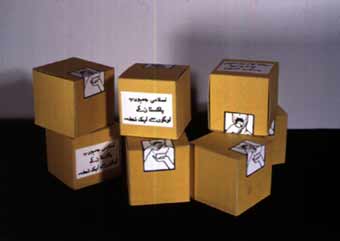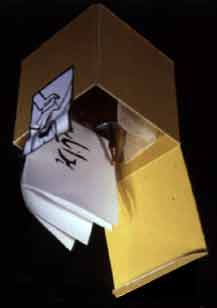|
The
poisonous gift of ‘First World’ aid after the event of terror:
|
 |
|
Stephen
Morton
University of Tampere, Finland
|
After
the attacks on the World Trade Center of September 11, 2001, the co-operation
of General Musharraf, the leader of Pakistan, in the United States war
in Afghanistan led to the removal of Pakistan from the U.S. State department’s
list of countries that sponsor terrorism, and the resumption of IMF
credit and debt relief to Pakistan. In response to this shift in geopolitical
relations between Pakistan and the US after September 11 2001, Alia
Hasan-Khan produced a series of small, yellow dessert boxes modelled
on the food packages that were randomly dropped from US military planes
flying at a high altitude over Afghanistan in October 2001. The original
US food packages contained instructions in English, French and Spanish:
languages which are not widely spoken or understood in Afghanistan.
These US food packages also displayed a diagram of how to eat the food
ration of 2200 calories contained inside the box, which included items
such as peanut butter and jelly, bean salad and shortbread; all of which
are unfamiliar to the majority of the Afghan people. What is more, these
food packages resembled in shape and colour the small, yellow cluster
bombs that were simultaneously dropped by the same US military planes
over areas of Afghanistan that were already littered with around ten
million unexploded land mines left over from the war with Russia. The
perilous consequences of the US government’s cynical aid campaign
during the attacks on Afghanistan thus prompted the US military to release
a radio broadcast emphasising the difference between the food packages
and the cluster bombs-
|
|
|
In
Gift Hasan-Khan inverted the geopolitical structure of ‘First world’
aid to ‘Third world’ countries by ‘donating’ fake
food packages to an American audience as part of a series of lunch time
seminars, about the US response to the terrorist attacks, held in the
financial district of Lower Manhattan. On the outside of each yellow
dessert box was an untranslated Urdu inscription, and a diagram instructing
the target-subject how to eat. Inside each box were more Urdu instructions
and a fake explosive device made up of gulab jamun (a piece of dessert
made with sweet curdled milk) with wire and hardware inserted inside
of it. By concealing such a device within the packaging of a ‘Third
world’ gift, Hasan-Khan foregrounds the paradoxical relation of
violence that underwrote the gift economy of US Aid to Afghanistan in
particular, and of ‘First world’ financial aid in general.
Instead of providing the means for economic independence, ‘First
world’ development loans to nations in the global South continue
to perpetuate a relation of economic dependence on First world banks
and industry-rich donor countries in the North. In the case of the US
aid program during the war in Afghanistan of 2001, as Hasan-Khan powerfully
demonstrates, the US military aid program did not even provide short-term
relief for Afghanistan’s civilians; instead it placed their lives
in further danger.
.
|
|

|
Yet
Hasan-Khan’s fake devices refuse to simply represent a tragic stereotype
of postcolonial subjectivity. By imitating the visual rhetoric of a
terrorist attack in public spaces, Hasan-Khan constructs a carnivalesque
space which encourages viewers to question the rhetoric of terrorism
and its economic and geopolitical agenda. Without denying the violence
of state democracies, extremist religious groups and military regimes
in Pakistan, the recycled devices also encourage the viewer to think
responsibly and critically about the violence which is historically
embedded in the western-based discourses of universal human rights and
representative democracy: discourses which are increasingly tethered
to the extension of economic dependency on global financial organisations
such as the World Bank and the International Monetary Fund. In doing
so, Hasan-Khan refuses to simply perform the role of postcolonial-migrant-artist-as-native-informant
in the United States art world.(1) Instead she articulates
the global economic conditions which foreclose the perspective of many
subaltern women in the global South whose debt and dependency —
either directly or indirectly — sustains the resource hungry lifestyle
of the North in the fabric and siting of the devices themselves.
|
1
In this respect, Hasan-Khan’s work might be read as a riposte to
Hal Foster’s model of the ‘Artist as Ethnographer’, a
model which perhaps forecloses the perspective of the native informant.
By refusing to perform the role of postcolonial-migrant-artist-as-native-informant,
Hasan-Khan also refuses to simply represent the (im)possible perspective
of the contemporary native informant, who Gayatri Spivak identifies
as ‘the poorest woman in the global South’. See Hal Foster
‘The Artist as Ethnographer’ in The Return of the Real Cambridge,
Mass. MIT, 1996: pp. 171-204 and Gayatri Chakravorty Spivak A Critique
of Postcolonial Reason: Towards a History of the Vanishing Present Cambridge,
Mass.: Harvard University Press, 1999: 6..
|
| |
|
| |
|
| Heterogénesis
Revista de artes visuales * Tidskrift för visuell konst
Box 760
220 07 Lund - Sweden
Tel/Fax: 0046 - 46 - 159307
e-mail:
heterogenesis@heterogenesis.com
|
|


